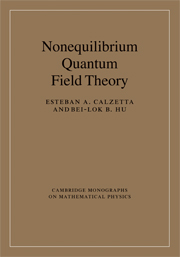Book contents
- Frontmatter
- Contents
- Preface
- I FUNDAMENTALS OF NONEQUILIBRIUM STATISTICAL MECHANICS
- II BASICS OF NONEQUILIBRIUM QUANTUM FIELD THEORY
- III GAUGE INVARIANCE, DISSIPATION, ENTROPY, NOISE AND DECOHERENCE
- IV THERMAL, KINETIC AND HYDRODYNAMIC REGIMES
- V APPLICATIONS TO SELECTED CURRENT RESEARCH
- 13 Nonequilibrium Bose–Einstein condensates
- 14 Nonequilibrium issues in RHICs and DCCs
- 15 Nonequilibrium quantum processes in the early universe
- References
- Index
13 - Nonequilibrium Bose–Einstein condensates
from V - APPLICATIONS TO SELECTED CURRENT RESEARCH
- Frontmatter
- Contents
- Preface
- I FUNDAMENTALS OF NONEQUILIBRIUM STATISTICAL MECHANICS
- II BASICS OF NONEQUILIBRIUM QUANTUM FIELD THEORY
- III GAUGE INVARIANCE, DISSIPATION, ENTROPY, NOISE AND DECOHERENCE
- IV THERMAL, KINETIC AND HYDRODYNAMIC REGIMES
- V APPLICATIONS TO SELECTED CURRENT RESEARCH
- 13 Nonequilibrium Bose–Einstein condensates
- 14 Nonequilibrium issues in RHICs and DCCs
- 15 Nonequilibrium quantum processes in the early universe
- References
- Index
Summary
Bose–Einstein condensation was predicted in 1925 [Ein24, Ein25] but, except for its indirect manifestation in the superfluidity of He4 [Lon38, Kap38, AllMis38], it remained a purely theoretical construct until 1995, when condensation in alkali gases was achieved in the laboratory [CorWie02, Ket02]. Since then, a great deal of the theoretical work in the previous 70 years has been put to the experimental test, while new avenues have been opening up, such as the superfluid-insulator or Mott transition [FWGF89, GMEHB02, CaHuRe06], the BEC-BCS cross-over [Leg06, Reg04] and the Tonks gas regime [Gir60, Par04]. Because of the great experimental control over the relevant parameters and the deep understanding of the fundamental physics, BECs have become a field of choice to perform experiments of interest not just in atomic and molecular physics, but also in quantum optics, condensed matter physics, quantum critical dynamics, even field theory, gravitation, cosmology and black hole physics [CoEnWi99, PetSmi02, Sou02, BonSen04, ParZha93, ParZha95, UnrSch07, BaLiVi05]. Moreover, cold Bose gases on optical lattices have been proposed as a possible implementation of a quantum information processing (QIP) device [JakZo104], boosting new interest in these systems.
As introductions and reviews on this fast evolving subject abound, it is perhaps more fitting for us to focus on certain aspects of the nonequilibrium field theory of BEC, specifically [And04] the application of quantum field theoretic methods described in this book to the description of nonequilibrium evolution of condensed gases in magneto-optical traps [ChCoPh95].
- Type
- Chapter
- Information
- Nonequilibrium Quantum Field Theory , pp. 391 - 428Publisher: Cambridge University PressPrint publication year: 2008



